Solar energy as an alternative source of energy: types and characteristics of solar systems
In the last decade, solar energy as an alternative source of energy has been increasingly used for heating and providing buildings with hot water. The main reason is the desire to replace traditional fuels with affordable, environmentally friendly and renewable energy sources.
The conversion of solar energy to heat occurs in solar systems - the design and principle of operation of the module determines the specifics of its application. In this material we will consider the types of solar collectors and the principles of their functioning, as well as talk about the popular models of solar modules.
The content of the article:
The feasibility of using a solar system
Heliosystem - a complex for converting solar radiation energy into heat, which is subsequently transferred to a heat exchanger to heat the heating medium of a heating system or water supply.
The efficiency of the solar thermal installation depends on solar insolation - the amount of energy supplied during one daylight per 1 square meter of surface located at an angle of 90 ° relative to the directivity of sunlight. The measured value of the indicator is kW * h / m2, the parameter value varies depending on the season.
The average level of solar insolation for the region of temperate continental climate is 1000-1200 kWh / sq.m (per year). The amount of sun is a determining parameter for calculating the performance of the solar system.

Installation of a solar heating system is an expensive undertaking. In order for capital expenditures to pay off, an accurate calculation of the system and adherence to installation technology is required.
Example. The average value of solar insolation for Tula in the middle of summer is 4.67 kV / sq.m * day, provided that the system panel is installed at an angle of 50 °. The solar collector capacity of 5 square meters is calculated as follows: 4.67 * 4 = 18.68 kW of heat per day. This volume is enough to heat 500 liters of water from a temperature of 17 ° C to 45 ° C.
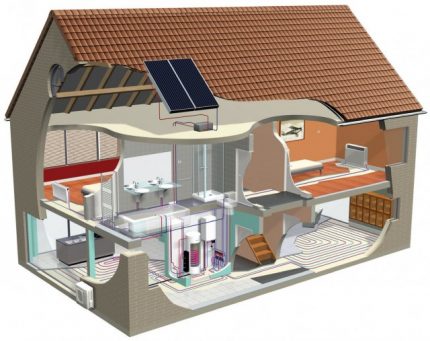
Speaking about the feasibility of introducing new technologies, it is important to take into account the technical features of a particular solar collector. Some begin to work at 80 W / sq.m of solar energy, while others need only 20 W / sq.m.
Even in a southern climate, the use of a collector system exclusively for heating will not pay off. If the installation will be used exclusively in winter with a shortage of sun, then the cost of equipment will not be covered for 15-20 years.
To use the heliocomplex as efficiently as possible, it must be included in the hot water supply system. Even in winter, a solar collector will allow you to "cut" energy bills for heating water to 40-50%.
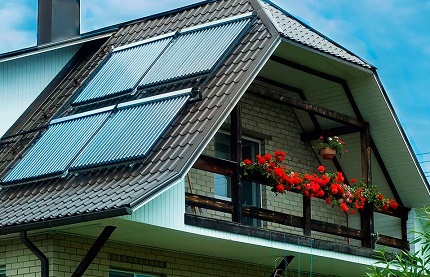
In addition to economic benefits, “solar heating” has additional advantages:
- Environmental friendliness. Carbon dioxide emissions are reduced. For a year, 1 square meter of the solar collector prevents 350-730 kg of mining from entering the atmosphere.
- Aesthetics. The space of a compact bathtub or kitchen can be eliminated from bulky boilers or geysers.
- Durability. Manufacturers claim that, subject to installation technology, the complex will last about 25-30 years. Many companies provide a warranty of up to 3 years.
Arguments against the use of solar energy: pronounced seasonality, weather dependence and high initial investment.
General arrangement and principle of operation
Consider a solar system with a collector as the main working element of the system. The appearance of the unit resembles a metal box, the front side of which is made of tempered glass. Inside the box there is a working body - a coil with an absorber.
The heat-absorbing block provides heating of the heat carrier - the circulating liquid, transfers the generated heat to the water supply circuit.
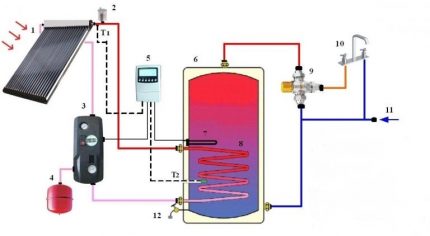
The solar collector must work in tandem with a storage tank. Since the coolant is heated to a temperature of 90-130 ° C, it cannot be fed directly to hot water taps or heating radiators. The coolant enters the boiler heat exchanger. The storage tank is often supplemented by an electric heater.
Scheme of work:
- The sun heats the surface collector.
- Thermal radiation is transmitted to the absorbing element (absorber), which contains the working fluid.
- The coolant circulating through the tubes of the coil is heated.
- Pumping equipment, a control and monitoring unit ensure the removal of the coolant through the pipeline to the coil of the storage tank.
- The heat is transferred to the water in the boiler.
- The cooled coolant flows back to the collector and the cycle repeats.
Heated water from the water heater is supplied to the heating circuit or to the water intake points.
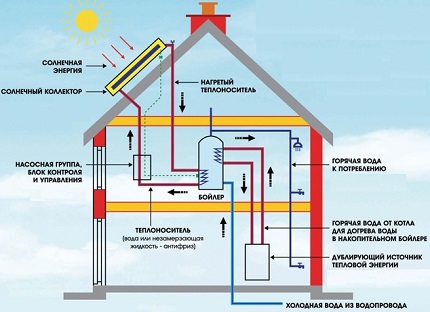
Solar panels in the arrangement of private houses are most often used as a backup source of electricity:
Varieties of solar collectors
Regardless of the purpose, the solar system is equipped with a flat or spherical tubular solar collector. Each of the options has a number of distinctive features in terms of technical characteristics and operational efficiency.
Vacuum - for cold and temperate climates
Structurally, a vacuum solar collector resembles a thermos - narrow tubes with a coolant are placed in flasks of a larger diameter. A vacuum layer is formed between the vessels, which is responsible for thermal insulation (heat preservation - up to 95%). The tubular shape is most optimal for keeping the vacuum and "occupation" of the sun's rays.

The inner (heat) tube is filled with saline with a low boiling point (24-25 ° C). When heated, the liquid evaporates - the vapor rises up the flask and heats the coolant circulating in the collector body.
In the process of condensation, water droplets flow into the tip of the tube and the process repeats.
Due to the presence of a vacuum layer, the liquid inside the heat bulb is able to boil and evaporate at minus street temperature (up to -35 ° С).
The characteristics of solar modules depend on such criteria:
- tube design - feather, coaxial;
- heat channel device - "Heat pipe"direct-flow circulation.
Feather bulb - a glass tube in which a plate absorber and a heat channel are enclosed. The vacuum layer passes through the entire length of the heat channel.
Coaxial tube - double flask with a vacuum "insert" between the walls of two tanks. Heat is transferred from the inside of the tube. The tip of the thermotube is equipped with a vacuum indicator.

The Heat pipe channel is the most common variant of heat transfer in solar collectors.
The mechanism of action is based on the placement of a volatile liquid in sealed metal tubes.
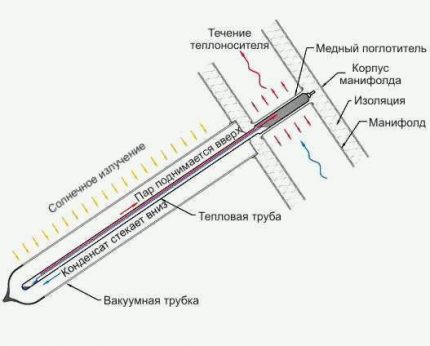
Direct-flow channel - parallel metal tubes connected into a U-shaped arc pass through a glass flask
The coolant flowing through the channel is heated and fed to the collector body.
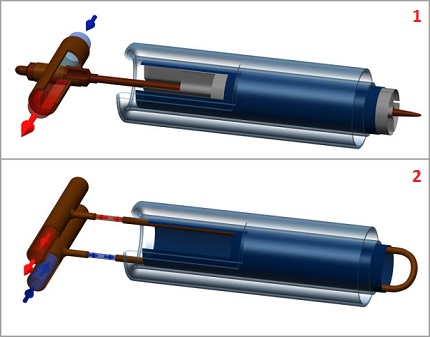
Coaxial and feather tubes can be combined with heat channels in different ways.
Option 1. Coaxial flask with "Heat pipe" is the most popular solution. In the collector, heat is repeatedly transferred from the walls of the glass tube to the inner flask, and then to the coolant. The degree of optical efficiency reaches 65%.

Option 2 Direct-flow coaxial flask is known as a U-shaped collector. Thanks to the design, heat losses are reduced - thermal energy from aluminum is transferred to the tubes with a circulating coolant.
Along with high efficiency (up to 75%), the model has disadvantages:
- complexity of installation - the flasks are a single unit with a two-pipe manifold body (mainfold) and are installed as a whole;
- single tube replacement is excluded.
In addition, the U-shaped unit is demanding on the coolant and more expensive than the “Heat pipe" models.

Option 3 Feather tube with the principle of action "Heat pipe". Distinctive features of the collector:
- high optical characteristics - efficiency of about 77%;
- flat absorber directly transfers heat energy to the heat transfer tube;
- through the use of a single layer of glass, the reflection of solar radiation is reduced;
It is possible to replace a damaged element without draining the coolant from the solar system.
Option 4 Direct-flow fountain flask is the most effective tool for using solar energy as an alternative source of energy for heating water or heating homes. High-performance collector works with an efficiency of 80%. The disadvantage of the system is the difficulty of repair.
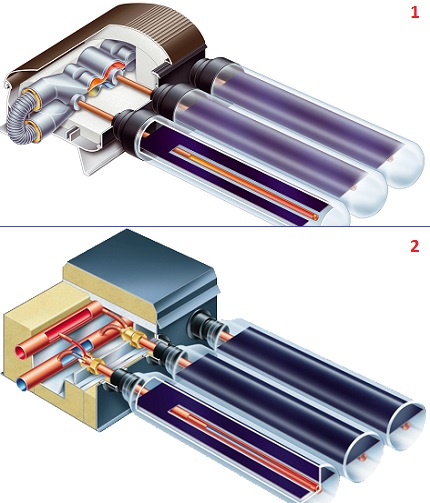
Regardless of the design, tubular manifolds have the following advantages:
- low temperature performance;
- low heat loss;
- duration of functioning during the day;
- the ability to heat the coolant to high temperatures;
- low windage;
- ease of installation.
The main disadvantage of vacuum models is the impossibility of self-cleaning from snow cover. The vacuum layer does not let heat out; therefore, the snow layer does not melt and blocks the access of the sun to the collector field. Additional disadvantages: high price and the need to comply with the working angle of the flask at least 20 °.
Solar collectors that heat the air coolant can be used in the preparation of hot water, if they are equipped with a storage tank:
Read more about the principle of operation of a vacuum solar collector with tubes. Further.
Water - the best option for the southern latitudes
Flat (panel) solar collector - a rectangular aluminum plate, closed on top with a plastic or glass cover. Inside the box is an absorption field, a metal coil and a layer of thermal insulation. The collector area is filled with a flow line through which the coolant moves.
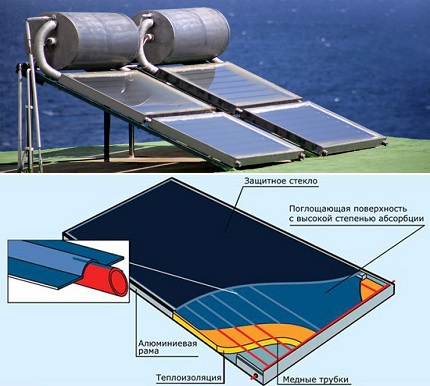
The heat absorption of a highly selective absorbent coating reaches 90%. A flowing metal pipe is placed between the “absorber” and the thermal insulation. Two tube-laying schemes are used: “harp” and “meander”.
The process of assembling solar collectors that heat the liquid coolant includes a number of traditional steps:
If the heating circuit is supplemented by a line supplying sanitary water to the hot water supply, it makes sense to connect a heat accumulator to the solar collector. The simplest option will be a tank of suitable capacity with thermal insulation, able to maintain the temperature of heated water. It must be installed on the flyover:
A tubular collector with a liquid coolant acts as a “greenhouse” effect - the sun's rays penetrate through the glass and warm up the pipeline. Thanks to tightness and thermal insulation, heat is retained inside the panel.
The strength of the solar module is largely determined by the material of the protective cover:
- ordinary glass - the cheapest and brittle coating;
- strained glass - high degree of light scattering and increased strength;
- anti-reflex glass - differs in the maximum absorbing ability (95%) due to the presence of a layer eliminating the reflection of the sun's rays;
- self-cleaning (polar) glass with titanium dioxide - organic pollution burns out in the sun, and the remnants of garbage are washed off by rain.
Polycarbonate glass is the most resistant to shock. The material is installed in expensive models.
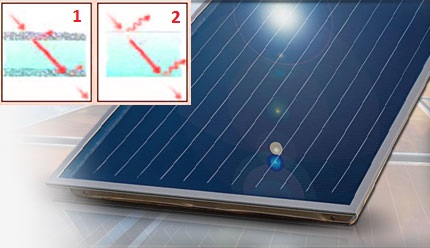
Operational and functional features of solar panels:
- in forced circulation systems, a thawing function is provided that allows you to quickly get rid of the snow cover on the heliopol;
- prismatic glass picks up a wide range of rays at different angles - in summer, the efficiency of the installation reaches 78-80%;
- the collector is not afraid of overheating - with an excess of thermal energy, forced cooling of the coolant is possible;
- increased impact resistance compared to tubular counterparts;
- the ability to mount at any angle;
- affordable pricing.
Systems are not without flaws. During a period of deficiency of solar radiation, as the temperature difference increases, the efficiency of a flat solar collector decreases significantly due to insufficient thermal insulation. Therefore, the panel module pays off in the summer or in regions with a warm climate.
Heliosystems: design and operation features
The diversity of solar systems can be classified by the following parameters: the method of using solar radiation, the method of circulation of the coolant, the number of circuits and the seasonality of operation.
Active and passive complex
A solar collector is provided in any solar energy conversion system. Based on the method of using the obtained heat, two types of heliocomplexes are distinguished: passive and active.
The first variety is the solar heating system, where the structural elements of the building act as the heat-absorbing element of solar radiation. The roof, the collector wall or the windows act as a helium-receiving surface.

In European countries, passive technologies are used in the construction of energy-efficient buildings. Helio-receiving surfaces decorate under false windows. Behind the glass coating is a blackened brick wall with light apertures.
The heat accumulators are structural elements - walls and floors, insulated with polystyrene from the outside.
Active systems involve the use of independent devices that are not related to the construction.
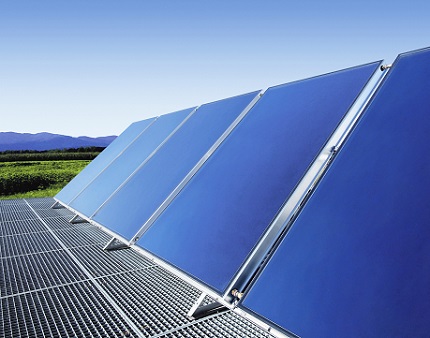
Thermosiphon and circulation systems
Solar thermal equipment with the natural movement of the coolant along the collector-accumulator-collector circuit is carried out by convection - warm liquid with a low density rises up, cooled liquid flows down.
In thermosiphon systems, the storage tank is located above the collector, providing spontaneous circulation of the coolant.
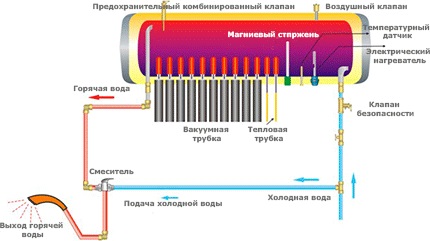
Non-pressure solar system has a wide list of disadvantages:
- on cloudy days, the performance of the complex decreases - a large temperature difference is required for the movement of the coolant;
- heat loss due to slow fluid movement;
- the risk of overheating of the tank due to the uncontrollability of the heating process;
- collector instability;
- the difficulty of placing the battery tank - when mounted on the roof, heat losses increase, corrosion processes are accelerated, there is a risk of freezing of the pipes.
Advantages of the “gravitational” system: simplicity of design and affordability.
Capital expenditures for arranging a circulation (forced) solar system are significantly higher than installing a pressure-free complex. A pump crashes into the circuit, providing coolant movement. The operation of the pumping station is controlled by the controller.
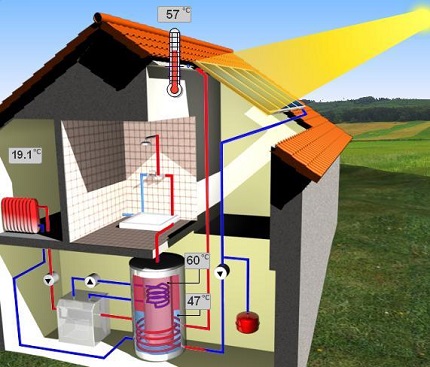
This method of circulation is used in year-round double-circuit solar thermal installations.
Pros of a fully functional complex:
- unlimited choice of the location of the storage tank;
- off-season performance;
- selection of the optimal heating mode;
- safety - blocking operation during overheating.
The disadvantage of the system is its dependence on electricity.
Technical solution schemes: one - and double-circuit
In single-circuit installations, liquid circulates, which is subsequently fed to the water intake points. In winter, the water from the system must be drained to prevent freezing and cracking of pipes.
Features of single-circuit solar thermal complexes:
- “refueling” of the system with purified, non-rigid water is recommended - salt settling on the pipe walls leads to clogging of channels and breakage of the collector;
- corrosion due to excess air in the water;
- limited service life - within four to five years;
- high efficiency in the summer.
In the dual-circuit solar complexes, a special coolant circulates (non-freezing fluid with anti-foaming and anti-corrosion additives), which transfers heat to the water through the heat exchanger.
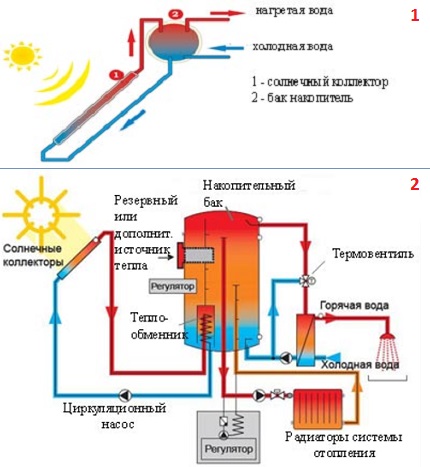
The nuances of operating a dual-circuit module: a slight decrease in efficiency (3-5% less than in a single-circuit system), the need for a complete replacement of the coolant every 7 years.
Conditions for working and increasing efficiency
Calculation and installation of the solar system is best entrusted to professionals. Compliance with the installation technique will ensure operability and obtaining the declared performance. To improve efficiency and service life, some nuances must be taken into account.
Thermostatic valve. In traditional heating systems thermostatic element rarely installed, since the heat generator is responsible for adjusting the temperature. However, when equipping the solar system, the safety valve must not be forgotten.
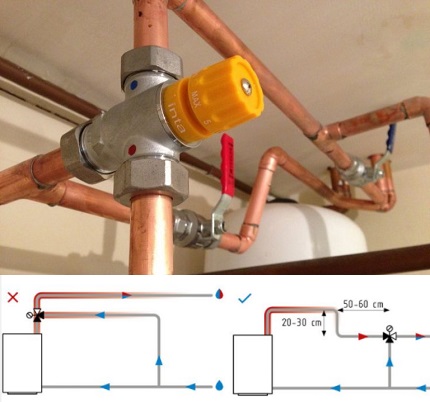
Optimum valve placement - 60 cm from the heater. At close proximity, the “thermostat” heats up and blocks the flow of hot water.
Battery tank placement. The DHW buffer capacity should be installed in an accessible place. When placed in a compact room, special attention is paid to the height of the ceilings.

Installation expansion tank. The element compensates for thermal expansion during stagnation. Installing the tank above the pumping equipment will provoke overheating of the membrane and its premature wear.
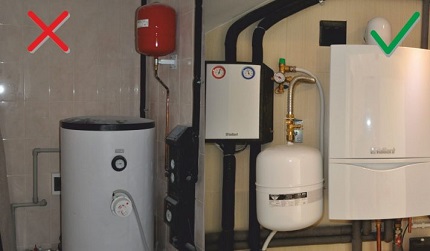
Solar connection. When connecting pipes, it is recommended to organize a loop. "Thermo Loop" reduces heat loss, preventing the release of heated fluid.
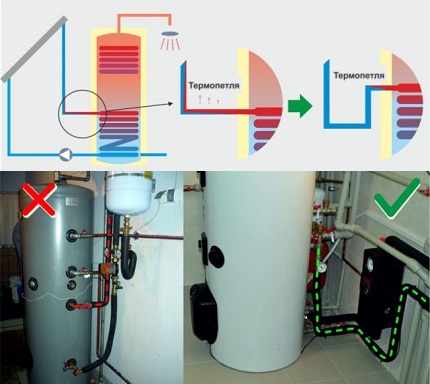
Non-return valve. Prevents "overturning" of the coolant circulation. With a lack of solar activity check valve prevents heat accumulated during the day.
Popular models of "solar" modules
Heliosystems of domestic and foreign companies are in demand.Products of manufacturers have won a good reputation: NPO Mashinostroeniya (Russia), Helion (Russia), Ariston (Italy), Alten (Ukraine), Viessman (Germany), Amcor (Israel), etc.
Solar system "Falcon". Flat solar collector equipped with a multilayer optical coating with magnetron sputtering. The minimum radiation ability and high absorption level provide an efficiency of up to 80%.
Performance characteristics:
- operating temperature - up to -21 ° С;
- reverse heat radiation - 3-5%;
- top layer - tempered glass (4 mm).
Collector SVK-A (Alten). Vacuum solar installation with an absorption area of 0.8-2.41 sq. M (depending on the model). The heat carrier is propylene glycol; the heat insulation of a 75 mm copper heat exchanger minimizes heat loss.
Extra options:
- case - anodized aluminum;
- heat exchanger diameter - 38 mm;
- isolation - mineral wool with anti-hygroscopic treatment;
- coating - borosilicate glass 3.3 mm;
- Efficiency - 98%.
Vitosol 100-F - flat solar collector for horizontal or vertical mounting. Copper absorber with harp-shaped tubular coil and heliotitan coating. Light transmission - 81%.

Conclusions and useful video on the topic
The principle of operation of solar collectors and their types:
Performance assessment of a flat collector at sub-zero temperatures:
Mounting technology for a solar panel collector using the Buderus model as an example:
Solar energy is a renewable source of heat. Given the increase in prices for traditional energy resources, the introduction of solar systems justifies capital investments and pays off in the next five years, subject to installation techniques.
If you have valuable information that you want to share with visitors to our site, please leave your comments in the block under the article. There you can ask interesting questions on the topic of the article or share the experience of using solar collectors.

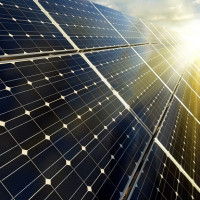 Alternative energy for the home: a review of non-standard energy sources
Alternative energy for the home: a review of non-standard energy sources 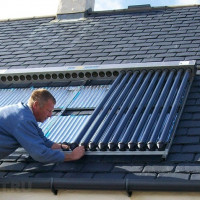 Solar heating of a private house: options and device diagrams
Solar heating of a private house: options and device diagrams  Do-it-yourself alternative energy for your home: a review of the best eco-technologies
Do-it-yourself alternative energy for your home: a review of the best eco-technologies 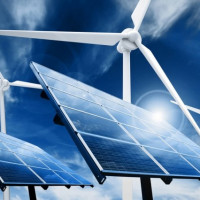 Alternative sources of heating for a country house: a comparative overview of eco-systems
Alternative sources of heating for a country house: a comparative overview of eco-systems 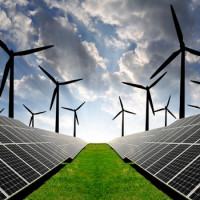 Autonomous power supply for a private house: an overview of the best local solutions
Autonomous power supply for a private house: an overview of the best local solutions  DIY eco-house construction: technological principles and schemes
DIY eco-house construction: technological principles and schemes  How much does it cost to connect gas to a private house: the price of organizing gas supply
How much does it cost to connect gas to a private house: the price of organizing gas supply  The best washing machines with dryer: model rating and customer tips
The best washing machines with dryer: model rating and customer tips  What is the color temperature of light and the nuances of choosing the temperature of the lamps to suit your needs
What is the color temperature of light and the nuances of choosing the temperature of the lamps to suit your needs  Replacement of a geyser in an apartment: replacement paperwork + basic norms and requirements
Replacement of a geyser in an apartment: replacement paperwork + basic norms and requirements
To use solar energy for lighting and heating a house is my dream. I will save up money and make it. My friend installed solar panels on the roof. The whole process of re-equipment cost 25 thousand dollars. Now they have enough electricity for the family and they are selling the state an excess. They calculated that the costs will pay off in 6 years, and then will receive income. Promising investment.
Your friend is disingenuous - a private person cannot sell electricity to the state. And the equipment does not last forever. It will be necessary to service it and repair.
We have to wait another 20 years so - maybe then it will be more accessible. But not in our country ...
Around this topic many more copies will be broken. Repeatedly read research with a skepticism about the payback of such projects. Apparently, here, after all, everything rests on the regional connection of the house. Even with electricity consumption of 1000 kW per month for 3 rubles, somehow $ 25k in 5 years does not work).
But on heating, in my opinion it is interesting. The only question that arises is whether the solar collector can take on full heating and hot water in mid-latitudes? Then the question of payback becomes secondary.
Hello. I also actively ask this question and here the problem is not in the middle latitudes, but in the duration of daylight hours. Batteries and collectors operate from sunlight, not from the heat of the sun.The duration of the light cycle in winter, night time, overcast season (and sometimes this weather lasts for weeks).
It becomes doubtful the version of manufacturers about a payback of 10 years, given the average battery life of 25 years and batteries of 12 years. And more and more seems to be a true version of the recently calculated return on investment of 45 years, which no longer seems so appropriate.
And how to calculate the payback for the Krasnodar Territory? Everything is fine with the number of sunny days. Will it be difficult to mount the panels yourself?
Hello, Boris. In the Krasnodar Territory, alternative energy is well developed, especially grid solar power plants (SES).
As for the payback, here it is necessary to carry out some calculations. To make it clearer, I will give an example on a finished project for the city of Sochi, a 10-kW SES. Immediately take into account the local electricity tariff of 7.9 rubles / kWh.
The cost of the SES itself is 590 thousand rubles, plus a bar and fastenings for the roof, consumables and installation work will cost 110 thousand rubles. In total, an amount of 700 thousand rubles is obtained.
I am enclosing a schedule for the total annual power generation of SES 10 kW per year, which is 15,900 kWh. The graph of average monthly savings shows that SES will allow to save the amount of 125 thousand rubles. in year.
It is easy to calculate that in Sochi such a station reaches a payback in 5 years.
Installation I advise you to entrust the team from an organization specializing in heat engineering installation to get an official guarantee.